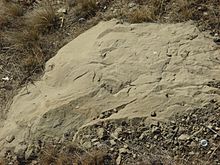Paskapoo Formation
| Paskapoo Formation Stratigraphic range: Paleocene |
|
|---|---|

|
|
| Type | Geological formation |
| Underlies | Tertiary gravel, Quaternary sediments, present erosional surface |
| Overlies | Scollard Formation, Coalspur Formation |
| Thickness | up to 600 metres (1,970 ft) |
| Lithology | |
| Primary | mudstone, siltstone, sandstone |
| Other | conglomerate, coal |
| Location | |
| Coordinates | 52°21′18″N 113°45′28″W / 52.355031°N 113.757797°W |
| Region |
|
| Country |
|
| Type section | |
| Named for | Paskapoo, "blind man" in Cree, from Blindman River |
| Named by | J.B. Tyrrell, 1887 |
The Paskapoo Formation is a stratigraphic unit of middle to late Paleocene age in the Western Canada Sedimentary Basin. The Paskapoo underlies much of southwestern Alberta, and takes the name from the Blindman River (paskapoo means "blind man" in Cree). It was first described from outcrops along that river, near its confluence with the Red Deer River north of the city of Red Deer, by J.B. Tyrrell in 1887. It is important for its freshwater aquifers, its coal resources, and its fossil record, as well as having been the source of sandstone for the construction of fire-resistant buildings in Calgary during the early 1900s.
The Paskapoo Formation is of fluvial origin and consists primarily of sandstones, siltstones and mudstones, with lesser amounts of pebble-conglomerate and coal, and minor bentonite. The sediments were derived from the Canadian Cordillera during tectonic uplift and erosion in the late stages of the Laramide Orogeny. They were transported eastward by river systems and deposited in fluvial and floodplain environments.
The sandstones were deposited in river channels. They are cross-bedded, medium- to coarse-grained, and locally conglomeratic. The siltstones and mudstones represent crevasse splay, overbank and shallow pond environments. They include plant fossils, rooted horizons and paleosols. Carbonaceous mudstones and coaly beds that represent oxygen-poor, swampy settings are thin and discontinuous, but common. Thick coal seams that formed in well-developed swamps are present only in the youngest portion of the formation, which is preserved near Hinton.
...
Wikipedia
